
The antifascist movement emerged in Russia in the late 1990s – early 2000s as a response to neo-Nazis’ violence: back then, the far-right was attacking migrants, homeless people, punks and anyone they didn’t like almost daily. Over the past couple of decades, the movement has changed significantly, having gone through murders of its participants, numerous criminal cases and now a split due to the war. Radio Svoboda (RS) recounts the story of Russian antifa. Author: Yana Sakhipova
On the title photo – action in memory of murdered antifascists in Moscow, 2015.
“Glory to Russia” – says a man in military uniform and raises a bottle of beer, while the band Klowns performs on stage under the flags of the so-called “DPR” and “LPR”. The musicians came to Donetsk in January of 2023 - as they claim, to do “a good deed” for the people that “have lived in cultural isolation” for the past nine years.
A significant part of the visitors is military men.
Klowns was one of the first and most popular antifascist bands in Russia. Now, only Sergei is left from the original lineup. And he doesn’t count himself as a member of antifa anymore. “I want Russia to be integral, so that Maidan wouldn’t be repeated here” - he says.
In three months and a hundred kilometers from Donetsk, in Bakhmut, the Russian antifascist and anarchist Dmitri Petrov will die while fighting on the Ukrainian side. “As an anarchist, revolutionary and Russian, I felt it necessary to take part in the armed resistance of Ukrainians against Putin’s occupants” – Petrov wrote in a letter he commanded to be published after his death. “I did it for the sake of justice, protection of Ukrainian society and of liberation of my own country – Russia- from oppression. For the sake of all the people, whom a heinous, totalitarian system, formed in Russia and Belarus, deprives of dignity and opportunity to breath freely”.
Even before February 2022, it would be difficult to call the Russian antifascist movement unitary. The full-scale war in Ukraine though literally scattered antifascists on different sides of the front. But it was starting very differently.
The 2000s
In 2002, the 13-year-old Inessa Dymnich went to a concert for the first time – the band was “Tarakany!”. At that time, Inessa was not interested in politics – she just liked punk rock. Before one of the following concerts, bottles flew on Inessa and people walking next to her, smashing against a wall above their heads. Back then this was becoming commonplace: concerts were regularly attacked by fascists.
Under the threat of an attack were performances of bands of various genres – from punk and hardcore to reggae and rap. An antifascist movement as such didn’t exist yet and the concerts often didn’t have a political orientation: the far-right simply didn’t like punks and representatives of other subcultures. Attacks were occurring not only in the clubs but also on the way to them.
“While on the bus, heading to the concert, you had to be constantly on the watch of what’s going on, are there any individuals dressed like the far-right. You could be attacked on your way out of the bus, at any passage. You were going out with a feeling that you’re waking into a fighting pit. You never knew what could be thrown at you on the way – a bottle, a stone, a fist. A part of people found themselves in antifascism because they were simply fed up constantly getting jumped on concerts” - recounts Inessa.
People had to walk from the metro in groups, while we were learning about the concerts by word of mouth: public announcements were too dangerous. This was not saving us from regular attacks and concert goers had to defend themselves by engaging in clashes with the Nazis – that way, gradually, a subcultural antifascist movement started to form. With time, antifascists started organizing the security of events.
“We used to gather people near the metro station with our security group. Those who had traumatic pistols were surrounding this crowd and were leading them to the club. If someone walked away alone to the bathroom or to a shop, he could be killed” - says Shura, an antifascist who was involved in the security of concerts. “Back then, when someone was coming to a concert without a gun everyone was looking at him in bewilderment: are you immortal?”
After a while Inessa also got involved in the security of concerts. She started getting interested in the ideological component of antifascism, as well - she found unacceptable the fact that some distinguish people on the basis of their nationality and looks, while the attacks on migrants and homeless were happening almost daily.
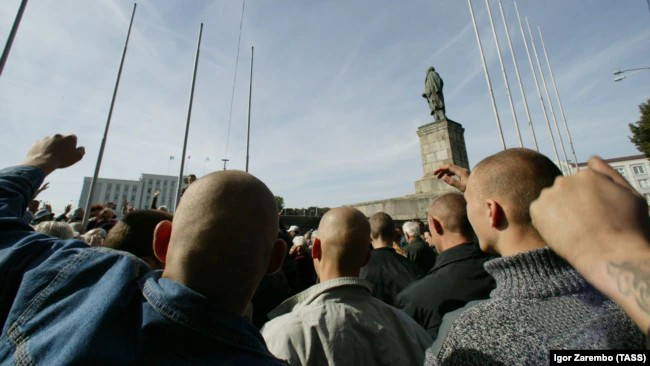
(Photo) Neo-Nazis at the rally “in defense of Russians rights”, 2004
The concept of antifascist resistance emerged at the beginning of 20thcentury in Italy and Germany, that back then were rapidly moving towards fascism and Nazism. In 1970-1980s, when in the post-war world the far-right started gaining power again, the antifascist movement was also reborn. Similarly, to the far-right, the new antifascist were not only a political movement but also a subculture, closely related to music and style – yet based on certain ideological principles. In that form the antifascist movement, or antifa, arrived in Russia about 30 years later.
In high school Inessa was writing slogans of the sort “Liberty, equality and fraternity”, “Against sexism and homophobia”, “Animal rights” on the margins of her notebook. Members of the antifascist movement consider those ideas as essential parts of it. They predominantly identify themselves as leftists – anarchists, in particular – that support the idea of self-governance and horizontal society without government and capitalism. Apart from music and common ideas, it was important to Inessa – which was the youngest out of the majority of her comrades – that she was treated as equal. That was a rare occurrence.
But the further, the scarier it was getting, says Inessa: throughout 2000s the level of street violence, including against antifascists, was continuously rising.
“At the beginning when someone was getting jumped we were telling ourselves “oh, they simply beat him up, that’s fine”. Later, “oh, they just stabbed him, that’s fine”. Later, “oh, they just smashed his head, that’s fine”. This was worsening exponentially, reaching up a moment when people started saying “oh, he got shot, at least he’s alive” – remembers the antifascist.
But even firearms were not a limit. At the end of December 2006 Inessa received a message from her friend Tigran Babadzhanian – the former administrator of Antifa.ru. Tigran was writing her that a bomb was planted at the entrance of his apartment building. On his way home, he discovered in the stairwell a wooden sign that read “In the 213 apartment live k*** (ethnic slur against natives of Caucasus)”. Tigran wanted to throw it away but noticed that some suspicious wires are connected to it. While Inessa was on her way home from university, they continued to text. The antifascist told her that he called the police and they are about to defuse the bomb. However, during the inspection, the bomb exploded and injured five policemen. Babadzhanian himself didn’t got hurt.
Some months later, neo-Nazis set off two explosions near “Vladimirskaia” metro station in Saint Petersburg – next to the place where each Sunday anarchists were feeding the homeless as part of the “Food not bombs” action. The first time the bomb exploded in a flower stall. It injured the saleswoman and two homeless men were thrown by the shock wave. Antifascists were late at that occasion and were not injured. After two weeks, the second blast occurred at “MacDonalds”, next to the same place. It injured six visitors of a coffee shop. The organizers of the explosions received from 6 to 15 years of imprisonment.
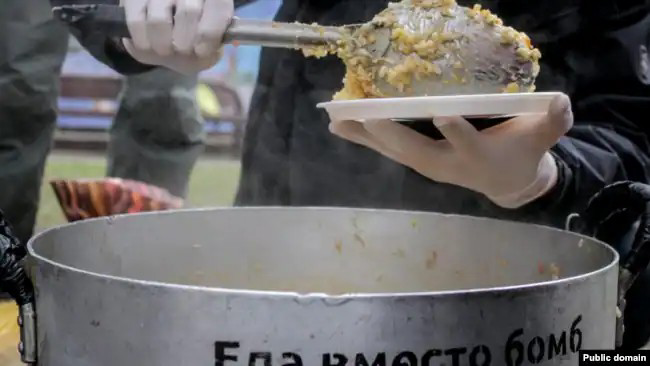
(photo) Action “Food not bombs”
In the same year, 2007, a bomb was found at an antifascist music festival in Saint Petersburg.
“On the stage there was a bag. I was standing next to that place” – tells Inessa. “At some point someone removed it. It was a big festival that was attended by people from different cities, including many active antifascists from Moscow. Had that bomb exploded (inside the bag they found a TNT block with a detonator, as well as a lot of bolds and nuts – RS), we would all be fucked. The whole of antifascism would had ended much earlier”.
Counter violence
“For some time, fascists are gathering at the entrance of one metro station. That’s their meeting point, in order to go later to Lumumba (People’s Friendship University of Russia) and beat up black students. We had long wanted to go there – as one of the attacks is described in the book titled “Beat the shit”. -We send there a scout, he checked. He says, there are 15 people. Us, we were 17. We arrived there and they were left with only 6. But, as we were already there, we jumped on them anyway. We did it quite effectively, we walked down the passageway, came close and attacked. Three out of four run away immediately, the rest took hits for all of them”.
If at the begging the antifascist movement solely protected itself, by the time antifascists themselves started launching attacks on far-right concerts, “Russian Marches”, actions of Movement Against Illegal Immigration and other gatherings of Nazis and neo-Nazis. That type of methods was criticized among antifascists as well, but as RS’s interviewees remember – in the 2000s the necessity of violence was commonplace in the movement.
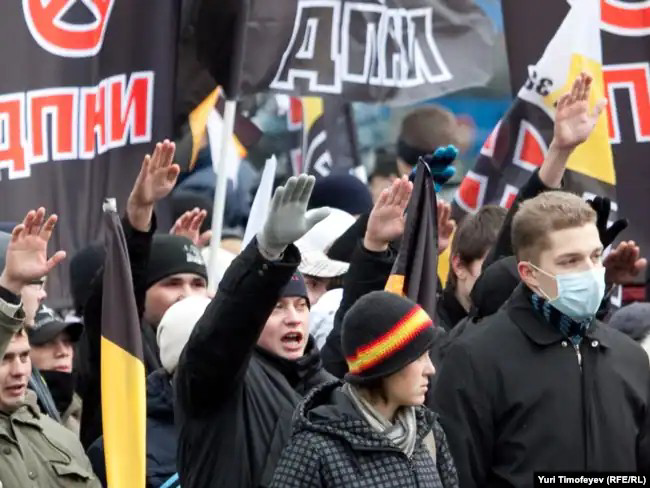
(photo) “Russian March” in Moscow. 2009
“It was the only thing that worked” – Inessa believes. “At the end we could carry out our events without being attacked. Of course, I - as any other reasonable person - ask myself, was the violence really justifiable? Because hitting on people’s heads is not the best thing. But, for some reason, I think that at that moment you couldn’t do otherwise”.
The lawyer Stanislav Markelov was justifying the necessity of violence in his book “The Red book of antifa”. He himself later became a victim of Russian neo-Nazis. “They will be telling us about humanism, but humanity is the protection of people, not an attempt to hide the disease, so that later we run out of power, while fighting against the epidemic. It’s better to hear today accusations of non-humanism, that argue about the right tactics in front of a gas chamber door” – Markelov wrote.
Now, the far-right was also afraid to hold open events or to gather in public places. It also helped to reduce the frequency of attacks on migrants. The supporters of violent methods were sure that neo-Nazis couldn’t feel their impunity anymore and, as a whole, the far-right movement was becoming less attractive to new members.
At some point, people that were attracted by the possibility of a fight itself started joining antifa – allegedly, in the name of high ideals.
“Antifascism in its core is honest, humane, kind. Well, if we take out the cracking of bottles on heads in alleys” – says Michail, musician of the antifascist band “Brigadir”. “And, unfortunately people with positions like “Fascists are bad, they wanted to conquer us, my grandfather has a medal hanging on his military coat. Basically, some of K*** (ethnic slur against natives of Caucasus) are out of line, and we will beat the shit out of all of those who went out of the line. They were just regular guys, sexists and homophobes among other things”.
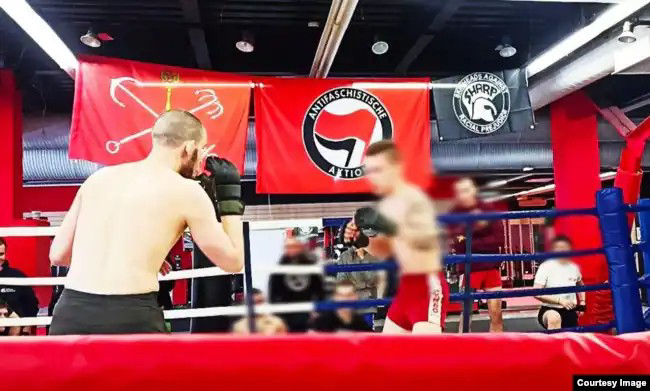
(photo) Antifascist tournament “Don’t give up”
Interviewees of Radio Svoboda are certain that for most, violence was not the main part of the movement. Antifascists were organizing pickets and demonstrations, drawing graffiti, feeding homeless people as part of the action “Food not bombs”, opening their own gyms, holding sports tournaments and movie screenings. Most of the times people were approaching the movement through music and concerts. Many – Mikhail believes – simply needed company, an opportunity to become a part of a subcultural community. “They were people traumatized by rough childhood and violence of the 90s, that believe in a better world. They were going to break somebody’s head with bottles in their hands, thinking that that’s the way that that better world will arrive.”
Murders
2008, Moscow. Around two hundred people gathered on Chistye Prudy. They were protesting against the rising pressure on activists and journalists. The lawyer Stanislav Markelov speaks from the rostrum: “I am tired of reading the crime reports and sifting through the lists of murdered people. This is not a job any more. At this point, it’s a matter of survival”.
A year after this speech Markelov will be murdered for his participation in trials against Nazis. With him, they will kill the journalist of “Novaya Gazeta” Anastasia Baburova – also an antifascist.
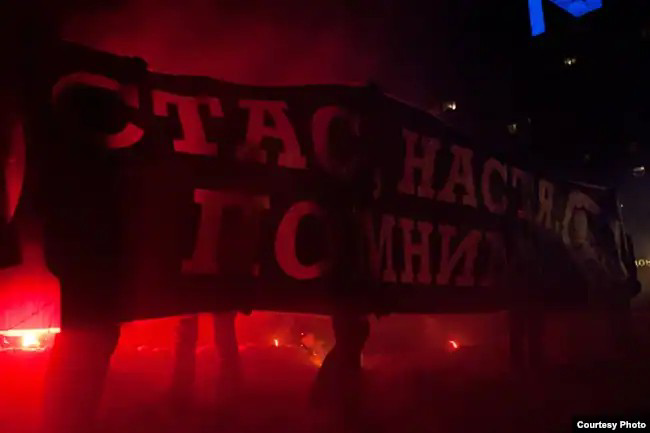
(photo) Antifascist action in memory of Stanislav Markelov and Anastasia Baburova in Moscow, 2012.
The murders of Markelov and Baburova became one of the last high-profile murders of antifascists in Russia, but before that, there were occurring systematically. According to the neo-Nazi Ilia Goriachev, who will later testify in court on the BORN (Combat Organization of Russian Nationalists) case, in many cases this was happening by order of authorities or at least with their acquiescence (even before that, the links between president’s administration and neo-Nazis were known).
The first murder of a member of antifascist movement occurred in 2005. Then neo-Nazis stabbed six times the 20-year-old Timur Kacharava. After half a year, right at a concert, they stabbed to death the 19- year-old Alexander Riukhin.
“We were about to go together, but I got very late – recounts Inessa. When I came I saw the uncovered body. I thought it was a different person. I remember very well the moment. We were standing next to the scene, the concert is not beginning, people are crying. I thought, poor people, they must have known the person. There, a friend tells me “You also knew him. Its Sasha”. And it finally dawns on me. I remember how I bit the sleeve of my hoodie out of pain, because it was simply unbearable. I was 17 back then”.
The second murder Inessa personally witnessed was of Aleksei Krylov. He was in a group that was heading to an antifascist punk concert that was attacked by the far-right. Krylov was not a specific target. He was killed accidentally.
In 2009 they shot Ivan Khutorskoy – one of the most active and prominent member of the movement. For his regular participation in fights with neo-Nazis he was nicknamed “Bonecrasher”. His name and address were regularly leaked on neo-Nazi websites, he was injured several times and the forth attack resulted in his death.
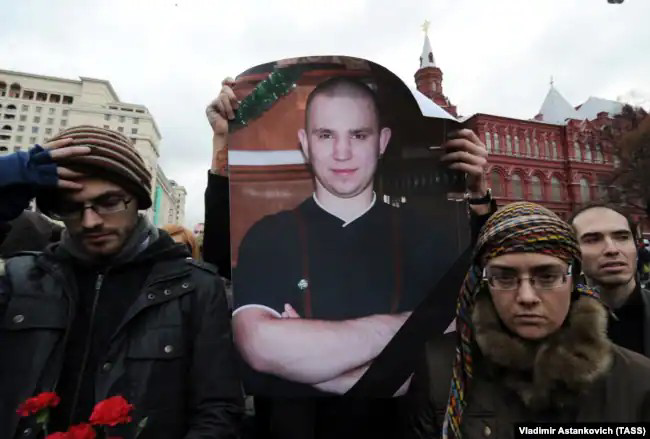
(photo) Action in memory of Ivan Khutorskoy in Moscow, 2009
To this, antifascists responded with the crushing of the pro-Kremlin movement “Young Russia” offices, the head of which – Maksim Mishchenko – they considered as the main ally with the Nazis in the Parliament. Participants called the action symbolic and highlighted that during the attack no one was hurt.
Inessa, Shura and other antifascists believe that the murder of Khutorskoy was a big hit for many people in the movement. They considered him as the older brother, a person to look up to. Khutorskoy was a lawyer in the foundation “Street children” that was working with disadvantaged kids. Inessa says that his relationships with antifascists, who were often from broken families, looked the same.
“It’s surprising to people from the outside that even after more than 10 years we, not only remember, not only visit his grave, but it’s as if this man continues to play some role in our live” – she says. “In reality, at the time of Vania’s death someone from the “base” was already in jail on falsified accusations, another was forced into hiding for the same reasons. This sounds like an overstatement, but I guess it was then, when that era ended”.
The end of an era
Year 2010. Some hundreds of people have gathered on Trubnaya square, where a performance of antifascist bands has been announced. “I hope we don’t have any losers who think that they’ve came here for a concert?” – a man in mask tells through a megaphone – and the crowd goes smashing Khimki’s administration. The building gets attacked with smoke bombs and bottles, windows are being smashed, walls are being painted with graffiti.
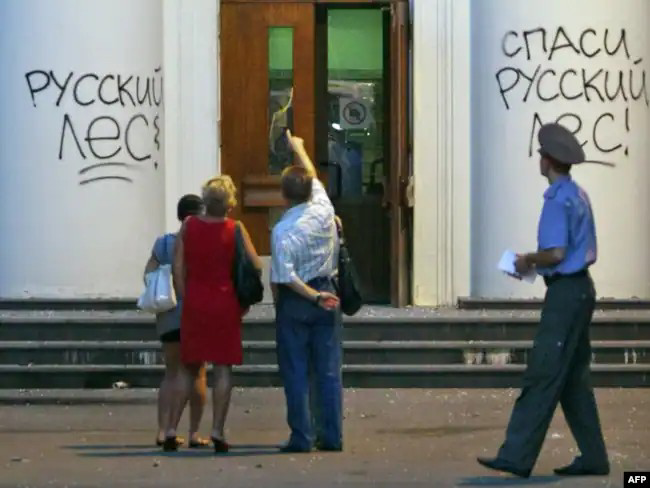
(photo) Police at the building of Khimki administration after the antifascist action
Antifascists held the action in defense of Khimki forest, that the authorities decided to cut in order to build a highway. The reason was the attack of people with Nazi tattoos on ecologist some days before. During the action antifascists remembered Mikhail Beketov as well – a journalist and defender of Khimki forest, who was beaten by unknown people two years before. As a result of the attack Beketov became disabled and after some years died.
After the pogrom a criminal case under the article “hooliganism” was opened, under which many activists and journalists were detained and questioned. A part of them left Russia. “Back then, the situation was you whether leave or go to jail” – says Shura.
Two antifascists – Aleksei Gaskarov and Maksim Solopov - were arrested. Two more – Petr Silaev and Maksim’s brother Denis Sopolov – who managed to flee Russia, were put on the international wanted list. Gasparov was unexpectedly acquitted a year later, while Sopolov was given two years of a suspended sentence.
The pressure on the leftists increased significantly after the next year’s “Bolotnaya case’ – defendants of which, among others, became antifascists.
Around the same time, they started actively prosecuting the far-right as well. A year before “Khimki case”, riots took place at Manezhnaya square. Then, thousands of football fans and nationalists held a meeting dedicated to Egor Sviridov, who was murdered during a fight with Caucasians. After the fight, more than 20 criminal cases on hooliganism and use of violence against authorities were opened. This started the pressure on primarily right-wing football environment, although soon after the meeting at Manezhnaya selected representatives of fans were even invited on a meeting with Putin.
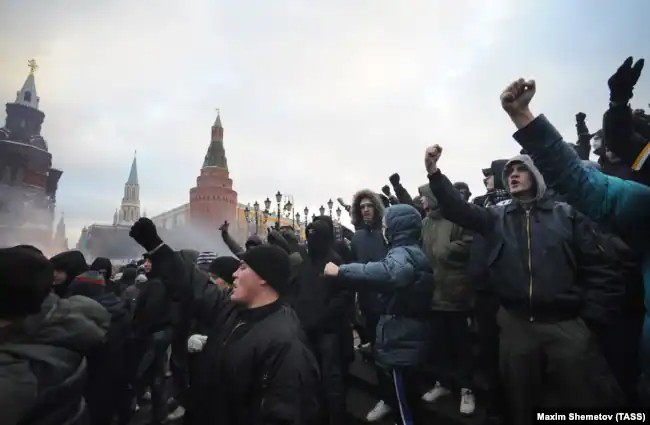
(photo) Action of football fans on Manezhnaya square.
Prison terms also received members of many combat neo-Nazi groups, some of which existed for years, for instance, NSO (National Socialist Society), NS/WP (National Socialism/White Power), National Socialist Workers’ Party and others.
In parallel, the far-right movement begun to withdraw from street violence and reform, gradually transitioning into the field of legal activities. Neo-Nazis now begun participating in social issues, for instance, in defense of the village “Rechnik” from demolition and other social actions.
“They started portraying the image of a nationalist with human face, not the animal grin of neo-Nazism, but something easier to digest to an average Russian” – notes Vera Alperovich of the information-analytical center “Sova”, that among other topics is focusing on xenophobia. “Even when we were dealing with expressions of xenophobia, the focus was not on anti-migrant sentiments, but on anti-police”.
In 2011 they arrested participants of the Combat Organization of Russian Nationalists (BORN), who killed many migrants and antifascists, including Markelov, Baburova, Khutorskoy and others. Some of the defendants received life sentences.
The last victim of the group was Moscow judge Eduard Chuvashov, who led the case against the Nazi band “White wolves” and other cases with murders of migrants.
“BORN was the final point in this story – says Alperovich. The murder of a judge showed that they’ve completely crossed the line. If the authorities could close their eyes to the murders or attacks on guys working at the market, then a Moscow judge is too much”.
The 2010s
At the beginning of 2010s the antifascist movement changed significantly: violent confrontations with the far-right lost their relevance, while direct action became practically impossible due increased police control. Antifascist moved to other actions: for instance, political protests, eco-activism, animal protection, protection of labor rights, support of LGBT organizations etc.
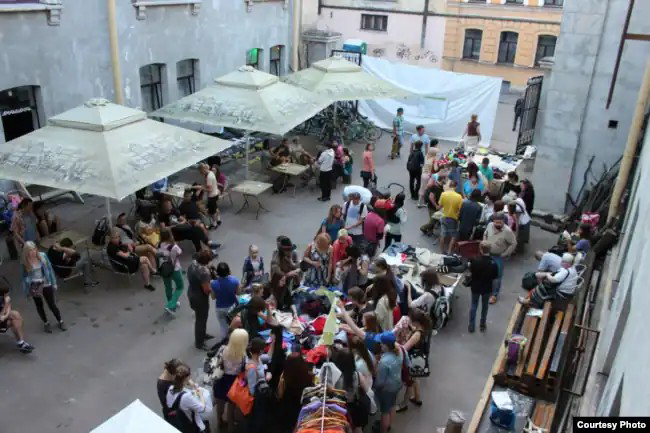
(photo) Free market held by anarchists. Saint Petersburg, 2013
From 2011 Inessa works on human rights issues: “My soul is at peace, because I don’t hunt for Nazis any more, but I’mdo things that are in line with the same ideas. Currently, among others, I do science, write about systemic discrimination. My values did not change, they just evolved and deepened”.
But many antifascists, that from the beginning were motivated by street confrontations with Nazis, have experienced this transformation difficultly. From Inessa’s observations, some – even those settled well in socially – faced with self-identification crisis started drinking and getting into fights.
“When the model was the street war, everything sucked, but was pretty clear. But when it disappeared, many could no longer understand how to live their lives. I think it’s similar to what happened to our parents with the fall of Soviet Union. They had a plan: I’ll be 25, I’ll finish university, I’ll go by appointment to wherever they send me, there,there I’ll meet my wife or husband, then we’ll have kids, andso forth. And then that plan vanished, and they’re like “what now?”. The plan of course sucked, I didn’t want to go wherever they send me, but, what am I going to donow?”
Still, the problem of the far-right violence didn’t disappear completely in 2010s. Nazis continued to attack migrants and antifascists, on concerts or simply on the streets, albeit less frequently and without killings. For instance, “Brigadir’s” member Mikhail said that in 2018 he was attacked by a group of right-wingers in Saint-Petersburg. Therefore, a part of antifascists continued to safeguard, now not only concerts but also feminist and LGBT events. But the main threat for antifascists became not their traditional enemies – the antifascist – but the state.
“This is the difference between the 2000s and 2010s” – says Shura. “In the 2000s you knew where the threat comes from, you choose the level of the threat and the level of your participation in it. In 2010s you did the same, but now the state could get you”.
Repressions
The culmination of the state pressure on antifascists was the - opened in 2017 – “Network” case. Eleven antifascists from Penza and Saint-Petersburg were arrested on accusations of participation in terrorist organization, which allegedly aimed to “destabilize the country”. The case was built mainly on testimonies of defendants, who, similarly to some witnesses, were subjected to tortures. Many of those, whose names were mentioned in the case, left Russia right away. With them, left many other antifascists who were afraid for their safety.
The arrested were later sentenced to terms ranging from 3,2 to 18 years of imprisonment. The human rights center “Memorial” recognized them as political prisoners.
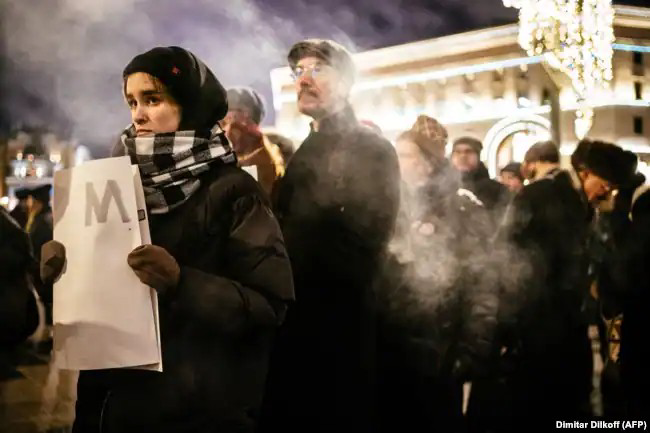
(photo) Protest after the sentence of Penza’s “Network” case, Moscow, 2020
In October 2018, the 17-year-old Mikhail Zhlobitski blew himself up in the building of Archangelsk’s FSB - having written beforehand in one of telegram chats that the security services “are fabricating criminal cases and torture people”. After that, a new series of raids and criminal cases against anarchists begun.
In 2018 they arrested the mathematician Azat Miftakhov, accusing him of arson of “United Russia’s” offices. In the same year, the 14-year-old Kirill Kuzminkin, who was allegedly preparing an explosion on “Russian March”, was arrested in Moscow. Then, there was the case against the anarchist Vyacheslav Lukichev, prosecutions of activists from Chelyabinsk for a banner in support of the “Network” case, the arrest of Evgeni Karakashev from Crimea for a message in a chat and other criminal cases, many of which involved torture.
In 2022 a new reason for repressions emerged – the war. Repression saffected members of the leftist movement that had antiwar stances. But, among antifascists there were people with opposite stances.
The War
“I believe that I can’t take a neutral or antiwar position. Russia must win – says Sergey, the vocalist of the band Klowns, that held a concert in Donetsk on January 2023. This is not just a confrontation between Russia and Ukraine, but of two systems – the West, represented by Ukraine and the Russian world. I see myself as part of it”.
Sergey considers Ukraine as the aggressor and says that Russia “should have started the special operation earlier” – that way it wouldn’t have been so lengthy. Sergey doesn’t call himself antifascist any more. He defines his views as communist, but he doesn’t see an adequate replacement for the power. “I haven’t lost critical thinking. And of course I don’t say that Putin shouldn’t be replaced. We have a constitution, elections. Clearly, people don’t trust them. But still, you have to act within the legal system”.
Sergey is far from the only, former or current, members of the antifascist movement that supports Russian aggression in Ukraine. Among them, there are also those who went to fight on the Russian side. For example, Anton Fatulaev, known in antifascist circles by the nickname Dolbila, died in Donbass on August 2014. He went there after being released from jail, where he was sent for a fight with right-wingers.
But that type of people are the minority in the antifascist movement – says an interviewee of Radio Svoboda. Many antifascists and anarchists are involved in antiwar activism; others went to fight on Ukrainian side.
The anarchist D. (the interviewee asked to be called like that), having moved some years ago from Russia to Ukraine, says that in the morning of 24 February he woke up from explosions. By lunch time, he went to enlist in the territory defense. “I don’t know how you can do otherwise in this situation. When I lived in Russia I believed that you have to fight the state by armed means. Therefore, when the “full-scale war” started, basically I choose the same”. 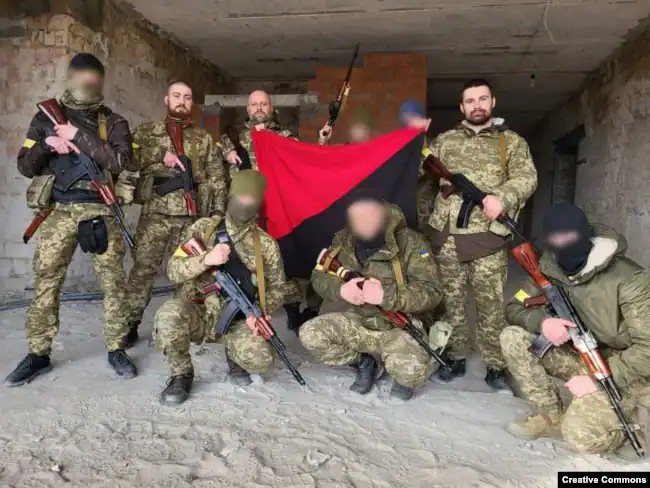
(photo) Members of the Anti-authoritarian platoon in Ukraine
At the beginning of the war, a group of antifascists and anarchists (to a great extent, consisting of Russians) created the Anti-authoritarian platoon as part of the territory defense. After some time, the platoon was disbanded, as its participants say due to military bureaucracy, and part of the people moved to other units. D. recounts that he is fighting alongside people with various views. Among others, he knows nationalists, whom he considers decent people, and says that in Ukraine this notion is perceived differently:
The Ukrainian nationalism, in its base, has antiimperialist and liberatory tendencies. I criticize right-winders on many topics, but I can’t deny that, for instance, “Azov” was holding Mariupol quite efficiently, committing acts of heroism. I do not support the ideology of nationalism, but there’s no discourse of the sort “we have to kill migrants”. It’s hard to find a person who openly espouses far-right views. They are very much marginalized”.
Anarchists often highlight that they don’t fight for the “corrupted, oligarchic” Ukrainian state, but for the society and people, the culture and identity of whom Russia tries to destroy deliberately – notes D. They call the war imperialist, having in mind Russia’s annexationist goals. But some antifascists, that prefer not to take sides, understand the “imperialist war” differently, believing that the Western imperialism is behind the Ukrainian war:
“This war is between the Russian and Ukrainian capital, that is supported by other capital – believes Oleg Smirnov, the vocalist of the antifascist band “Brigadir”. Ukraine defends the right to choose whom to serve – the Russian or the European capital. Yes, of course Russia in this situation is the aggressor. But this doesn’t mean that a Ukrainian worker must go and fight against Russia. They shouldn’t be participating in imperialist and capitalist clashes. The only solution is massive desertion. Let the generals fight each other”.
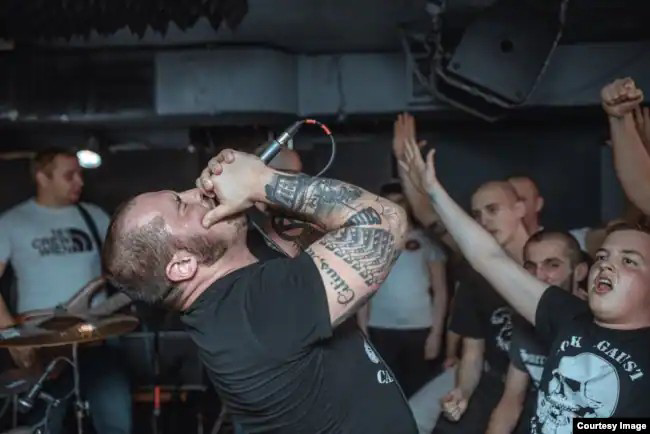
(photo) the antifascist Oleg Smirnov during a performance of the band “Brigadir”. Saint-Petersburg, 2019.
Michail, another member of “Brigadir” doesn’t agree and doesn’t understand how can one expect social revolution, when houses are bombarded by missiles and millions have become refugees. From humanitarian and pacifist standpoint, he considers the calls to send “Leopards” to Ukraine wrong, but considers inevitable the supply of arms by Western countries.
Many members of the antifascist movement have left the street struggle, but actualized themselves in fields that are in line with the values. For others, the main motivation for their participation in the movement were external attributes, music, style and street violence. “Instead of fighting with the Nazis, they could as well defend their neighborhood” – says Inessa.
Having lost the foundation – the direct confrontation with neo-Nazis – Russian antifascists stopped being a unified movement and the war has simply highlighted that divide. “There were always the apolitical antifascist, Stalinists, hardcore machistas and other bastards in the movement. Now, we’re in a crisis and people got divided to different sides” – says D.
Shura, that is helping refugees and supports Ukrainians – “those who defend their homes” – also thinks that the antifascists who currently hold pro-war stances “were already rotten. I watch the video (of pro-war concerts of antifascist groups) and think, this bastard met my expectations. So, nothing has changed.”
Mikhail, among others, connects the split with the environment people grew up. He thinks that you can’t expect reason from people that were always living in violence. According to him, many have mental health problems due to their background.
Almost no one of RS’s interviewees lives in Russia anymore. Nearly all of them agree on the fact that there’s nothing good to expect from the near future.
“Of course the war will end, but things won’t get better right away. The most terrifying is that for things to get better, at first, they have to get very bad. Everything has to collapse, so that later you could reassemble something from the pieces” – says Inessa, that currently is a member of one of the cells of the Feminist Antiwar Resistance, participates in public events and is volunteers in organizations that help people affected by Russia’s attack on Ukraine.
The future of the antifascist movement – at least, in the form in which it was created 20 years ago – remains uncertain. Mikhail believes that violence has returned on the streets. But the confrontation is not the same. “I can’t claim that the problem with Nazis faded away. People of far-right beliefs with guns didn’t disappear. The threat remains. It’s just that now, the confrontation is between “Russia-Ukraine”, not fascists against antifascists. Moreover, he adds, the meanings of “fascism” is distorted by Russian propaganda – “According to Russia’s rhetoric, currently, Zelensky is on fascists’ side, while on antifa’s side - it’s Putin”.
Despite that, people experienced in organized antifascist movement do a lot of good, as we speak – from helping activists detained for antiwar actions, to volunteering and fundraising. “I live in the present moment” – says Mikhail. “I have already lost hope that in the near future things will get better. And as long as things are so bad, it’s worth trying to make them less bad, at least in the moment”.

Add new comment